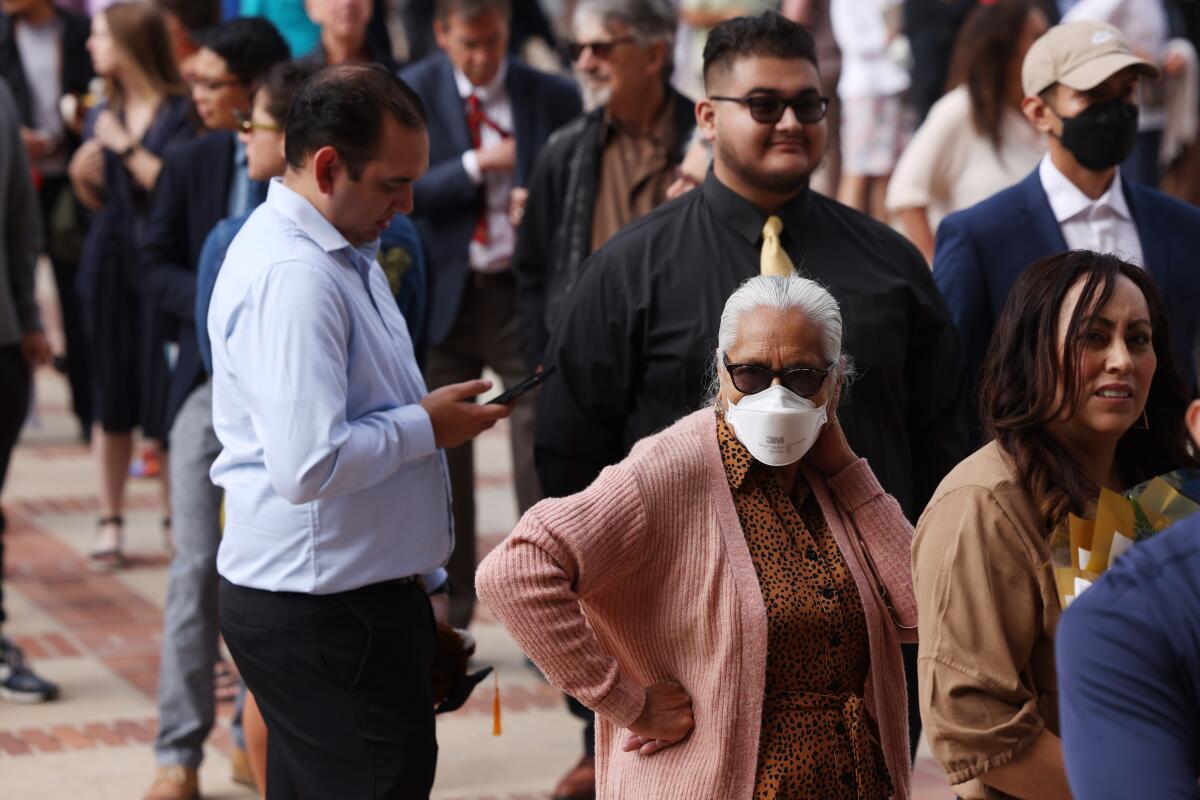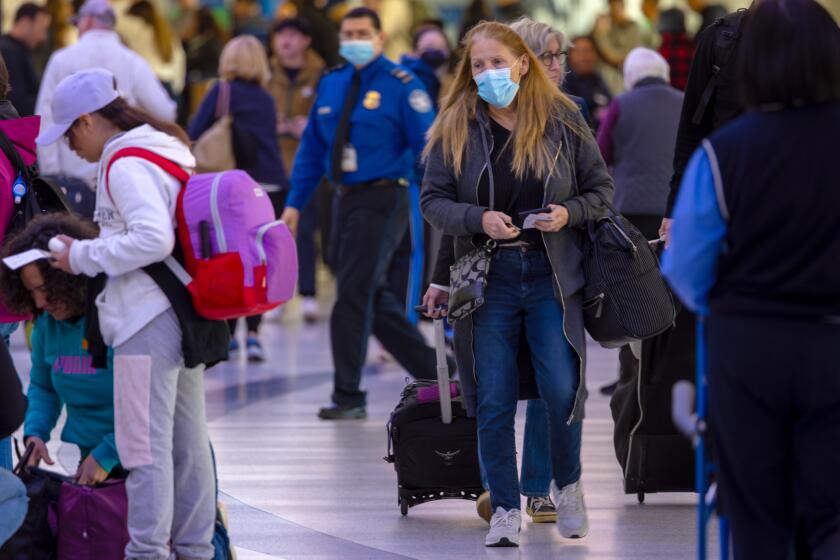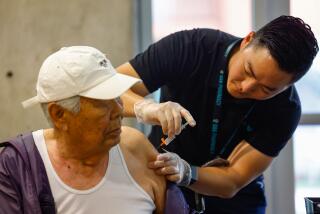COVID cases keep rising in L.A. County due to FLiRT; Mayor Karen Bass tests positive

- Share via
COVID-19 cases are continuing to climb in Los Angeles County, as are the number of people hospitalized with infections, as the typical summer surge in the illness creeps up.
Among those recently testing positive for the coronavirus was Los Angeles Mayor Karen Bass, whose office disclosed the result Friday morning, shortly before she spoke at a press conference virtually, through Zoom. The mayor first tested positive for the virus in June 2023.
The rise of COVID in California comes as levels of coronavirus in the state’s wastewater remain high, according to the U.S. Centers for Disease Control and Prevention.
Doctors have noted an earlier-than-normal rise for this time of year, beginning in May in L.A. County. The midyear rise in county COVID cases and hospitalizations didn’t begin until early July in 2021 and 2023, though in 2022 it started in early May.
For the week ending June 23, the most current data available, reported cases averaged 215 per day, up from 154 the prior week. A month before that — for the week that ended May 26 — an average of 83 cases a day were reported.
The official tally is an undercount, as it includes only tests done at medical facilities. The tally does not reflect positive at-home tests or take into account that far fewer people are tested once they’re sick. But the tallies are still helpful in detecting trends, such as when COVID is on the upswing.
The latest count shows the most new coronavirus cases per day since February’s tally, as the virus’ winter peak was trending down. The peak rate in the winter was 621 cases a day; last summer, it was 571 cases a day.
The rate at which COVID tests are coming back with positive results is swinging up across California. For the week that ended June 24, 9% of tests showed positive results; a month earlier, the positive rate was 3.4%. Last summer’s peak rate was 13.1%.
New subvariants of the coronavirus, labeled FLiRT, are increasingly edging out the previous dominant strain of the virus.
The new FLiRT subvariants, officially known as KP.3, KP.2 and KP.1.1, are believed to be roughly 20% more transmissible than their parent, JN.1, the winter’s dominant subvariant, Dr. Peter Chin-Hong, an infectious-disease expert at UC San Francisco, has said.
For the two-week period that ended June 22, the most recent information available, 62.9% of estimated COVID specimens in the U.S. were of the FLiRT variants — up from 45.3% a month earlier.
Despite their increased transmissibility, the new mutations do not appear to result in more severe disease.
In years past, summer travel and gatherings have spurred surges in coronavirus infections. As immunity wanes for those who received the most recent vaccine, experts urge caution.
Coronavirus-positive hospitalizations also are ticking upward. For the week that ended June 22, there were an average of 153 patients in L.A. County hospitals per day, up from 138 the prior week. Last summer’s peak was an average of 620 patients per day, and the winter’s was 825.
The share of emergency room visits related to the coronavirus is also up. For the week ending June 23,
2.1% of ER visits in L.A. County were coronavirus-related; a month before that, the number was 1.2%. Last summer, that share peaked at 5.1% toward the end of August.
Despite those upticks, coronavirus levels in L.A. County wastewater have remained largely stable of late. For the week that ended June 15, the most recent data available, coronavirus levels in sewage were at 17% of the 2022-23 winter peak. That’s slightly up from the 15% the previous week, which was an increase from 13% the week before. But the week before that, the level was 16%.
Last summer saw coronavirus levels in L.A. County wastewater reach a high of 38% of the peak from the winter of 2022-23.
A number of places in California have seen rising coronavirus levels in wastewater. Santa Clara County, Northern California’s most populous, continues to report high coronavirus levels in a swath of Silicon Valley, from San Jose to Palo Alto.
Fourteen states, including California, are showing high or very high coronavirus levels in their wastewater. California is among nine states with high levels, along with Arkansas, Louisiana, Maryland, Massachusetts, Missouri, Texas, Washington and Wyoming. The five states with very high levels of coronavirus in sewage are Florida, Hawaii, Nevada, New Mexico and Utah.
COVID death rates have remained stable in L.A. County. For the week that ended June 4, the most recent information available, the county’s average was fewer than one COVID death a day.
Summer surges in the virus typically coincide with an increase in travel and group gatherings. And with the majority of the population having long ditched their masks, the chances for infection are higher. Further increasing the likelihood of infection is the fact that most people who have been vaccinated are far removed from their last COVID-19 booster shot.
Across California, 36.2% of seniors have received at least one dose of the updated COVID vaccine since September, when it was introduced. Just 18.3% of adults ages 50 to 64 received an updated vaccine in that time; among younger adults, up to age 49, only 9.7% have done so.
The CDC says everyone ages 6 months and older should have gotten at least one updated shot since September, or two shots for seniors 65 and older who are four months out from their first updated dose.
People who are immunocompromised can get an additional updated shot two months after the last recommended dose, and can speak with their healthcare providers about whether further doses are needed.
A new updated formula for the COVID vaccine is expected in the fall. On Thursday, the CDC recommended that after the vaccine comes out, perhaps starting in September, everyone 6 months and older should get the updated 2024-25 version of the vaccine.
“Our top recommendation for protecting yourself and your loved ones from respiratory illness is to get vaccinated,” CDC Director Dr. Mandy Cohen said in a statement. “Make a plan now for you and your family to get both updated flu and COVID vaccines this fall, ahead of the respiratory virus season.”
More to Read
Sign up for Essential California
The most important California stories and recommendations in your inbox every morning.
You may occasionally receive promotional content from the Los Angeles Times.












